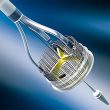In recent years, TAVR has been increasingly used; however, when it comes to younger, lower risk patients, its use is still challenged. In this context, there is limited information and we lack randomized studies on “real world” cohorts. The DEDICATE randomized 1.414 patients over 65 with severe symptomatic aortic stenosis. 701 of these patients received...
SOLACI/SBHCI 2023: Scientific Coverage – Day 2
The second day of the SOLACI/SBHCI 2023 Congress, the largest interventional cardiology meeting in Latin America, organized by the Latin American Society of Interventional Cardiology (SOLACI) and the Brazilian Society of Hemodynamics and Interventional Cardiology (SBHCI), held in Rio de Janeiro, featured various national and international guests, along with important sessions on the main topics...
TCT 2022 | PROTECTED TAVR
Stroke is still a major complication of transcatheter aortic valve replacement (TAVR), with a 30-day mortality of 16.7%. Even in the absence of symptoms, most patients (68-93%) have some type of diffusion imaging defect after TAVR implantation. The Sentinel cerebral protection device (CPD) (Boston Scientific) received FDA approval for the capture of emboligenic material that...
Dual Antiplatelet Therapy and TAVR: Obsolete Guidelines
The current guidelines recommend dual antiplatelet therapy (DAPT) 3 to 6 months after transcatheter aortic valve replacement (TAVI). Some recent data finally condensed in the present meta-analysis and recently published in JAHA happen to challenge these guidelines. Clinical studies that investigated single antiplatelet therapy versus DAPT until November 2020 were analyzed and divided according to...
IVUS vs OCT to Guide PCI: Which Should We Choose?
Controlling stent expansion with optical coherence tomography (OCT) based on an external elastic membrane–based protocol for stent sizing resulted non-inferior to the control group which used intravascular ultrasound (IVUS) and superior the angiography only group. Based on these study outcomes and the prior outcomes, we should use IVUS imaging if available. There are no specific algorithms...
Silent Stroke During TAVR and Early Cognitive Impairment
Silent stroke is common after transcatheter aortic valve replacement (TAVR). Co-morbidities such as diabetes or chronic renal failure, as well as procedural factors such as pre-dilation, increase the risk of silent stroke. While many events of silent stroke have an early effect on cognition, it is necessary to learn whether the impairment is sustained over...
Do We Need to See a Cardiologist before a Carotid Endarterectomy?
Cardiac complications are among the most frequent in patients undergoing carotid endarterectomy for asymptomatic lesions. This excess of cardiac events in patients with no neurological symptoms of carotid stenosis is essential to balance the risk/benefit ratio of carotid endarterectomy. A routine cardiology consultation prior surgery could reduce perioperative infarction rate, general complications and even mortality. ...
Asymptomatic Carotid Artery Stenosis: Do We Have All the Answers?
Advancements in therapies to reduce the impact of stroke in asymptomatic carotid artery stenosis have been hard to come by over the last decade. Several points of disagreement among published randomized trials prevented their information from being integrated into daily clinical practice. However, over the past 5 years, there has been some alignment, allowing for this...
Lotus Returns with New Strength and the FDA Approval to Compete with Sapien3 and CoreValve Evolut R
After reports of some serious adverse events with first-generation Lotus, the device was pulled off the market—but it was not meant to be left in oblivion. Now, it is back, renewed and with the approval of the United States Food and Drug Administration (FDA), to compete directly with the two market leaders (Sapien and CoreValve),...
We Must Still Fear the “Big Five Complications” After TAVR
Surgical risk scores cannot be used for transcatheter aortic valve replacement (TAVR) and they usually overestimate procedural risk. There are 5 big complications after TAVR, specifically, that cannot be predicted by conventional surgical scores. These 5 peri-procedural complications are considered important because they have a somewhat significant impact on survival after TAVR. They are: 1)...









